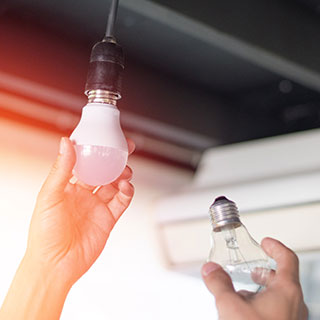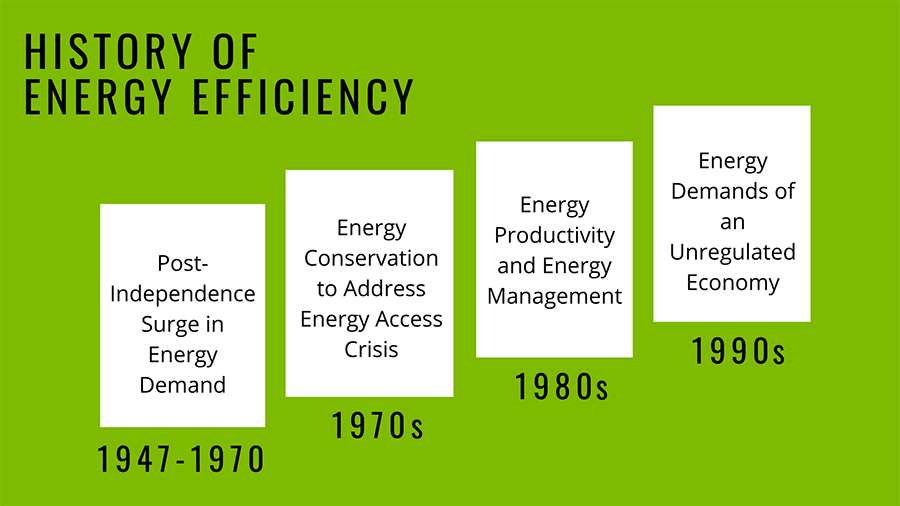Energy Conservation and Efficiency: A Time Capsule


Understanding the journey of energy conservation and efficiency is crucial to promoting behavioural change in India, especially even more in the Decade of Action, when we are all faced with the extreme impacts of climate change across the world. Realising this need, here is a capsule that journeys back to the inception of the concept of energy conservation and efficiency in India for all of you.
Introduction
A national interest in energy conservation in India began in the 1970s as an outcome of the global oil crisis triggered in 1973 with the onset of the Yom Kippur war. As energy fuelled the rising aspirations of a growing industrial economy, it was evident that drastic reductions in consumption would be difficult. Every sector, be it industry, infrastructure, agriculture or housing depended on energy inputs. Reduction in wastage and higher efficiency in use was the key. The potential for conservation and increasing efficiency was huge – from exploration, refining, pipelines and transportation to retailing (in the case of liquid fuels); and in the case of electricity – from power plants to transmission and distribution, and end-use in appliances. However, there was still a long way to go before energy conservation and efficiency was incorporated into various policies and legislation as we see today.
The earliest approach to efficiency was primarily awareness creation through print and electronic media (radio in those days). At the time, the primary effort came from the ministries dealing with petroleum fuels and (to a smaller extent) electricity, which aimed at creating awareness about energy efficiency and conservation issues. The government’s emphasis was mainly on identifying supply sources to meet growing demand.
1947-1970: Post-Independence Surge in Energy Demand
The Indian Electricity Act 1910, provided the basic framework for electricity supply in India. The period immediately after independence saw the introduction of many new policies, legislation and programmes aimed at progress and development of the country. Electricity was one of the sectors which received attention during this period; the primary concern was the supply of electricity, and also oil and coal, to support growth; conservation of energy was not a matter of priority during the first 15-20 years after independence.
- The Electricity (Supply) Act of 1948 was created to aid co-ordinated development of electricity, which was identified to be of increasingly urgent importance for post-war re-construction and development. It allowed for the creation of the Central Electricity Authority (CEA) in 1950, to develop “sound, adequate and uniform” national power policies and co-ordinate development.
- The Planning Commission was set up in March 1950 and charged with the responsibility of assessing of all resources in the country, augmenting deficient resources, formulating plans for the most effective and balanced utilisation of resources and determining priorities.
- One of the earliest movements to promote “productivity culture” in India was started by the Government of India, when the National Productivity Council (NPC) was set up in 1958. Besides providing training and consultancy, the NPC undertook research in the area of productivity. This coincided with the formation, in 1959, of the Tokyo based Asian Productivity Organisation (APO), an inter-governmental body of which the Government of India was a founding member. NPC became the rallying point for efficiency in fuel and energy over the next few years and was the focal point for some of the earliest international support and exchange from the UK, Japan and other developed countries.
- Integrated Energy Planning was recognised as an essential element of development planning in India as early as the sixties, but with very little focus on Demand Side Management (DSM). The Energy Survey of India Committee (ESIC) was established in 1963 to study demand and supply of energy on a national, regional and sectoral basis. The study was to provide the government with a framework for energy development planning until 1981, with specific focus on rural energy requirements.
The 1970s: Energy Conservation to Address Energy Access Crisis
As industrial production grew, energy became even more vital for the country. Industry accounted for nearly two-thirds of consumption in the form of furnace oil; power was a growing and major consumer. Dependence on petroleum, particularly fuels used in household and transport sectors, had risen to technologically unmanageable levels.
1973 was a turning point for India, and indeed, the world. In response to a US decision to support Israel in the Yom Kippur war between Israel and a coalition of Arab states, the Organisation of Petroleum Exporting Countries (OPEC) announced an oil embargo. The consequent increase in the price of petroleum products led to a world-wide rise in the price of oil, introduced rationing for the first time, and triggered efforts towards energy conservation. The increased oil prices were particularly difficult for oil-importing developing countries since they did not have the financial wherewithal of developed countries to respond to the increased prices.
In 1979, the Iranian revolution affected Iran’s oil production and Saudi Arabia announced cuts in production which drove oil prices further up.
By the end of the 1960s, the government realised the need for understanding the supply-demand balances over the next two decades in order to plan for the energy requirements of the country. The Fuel Policy Committee (FPC) was set up in 1970 to develop the country’s national fuel policy for the next 15 years. T L Sankar, who headed the FPC, introduced the concept of efficient use of fuel. He was involved in working with energy-related issues in a 2 number of capacities. The FPC adopted techniques like the econometric forecasting and end-use analysis in arriving at sectoral energy demand estimates. The focus of the Committee was on the necessity of substitution of oil by coal and higher efficiency in electricity generation and transmission with special attention to hydel power developments.
The 1973 world oil crisis made the FPC consider the implications of the crisis on the Indian economy. As a result, the recommendations made by the Committee in its final report in 1974 included substitution of oil by coal and electricity, and promoted energy conservation in general. The study highlighted the supply side of energy.
An inter-ministerial body called the Standing Committee on Furnace Oil consisting of members from the petroleum, coal, power and railway ministries was set up by the government as the main implementing mechanism, chaired by the Directorate General of Technical Development (DGTD). To provide the necessary technical support, the Energy Conservation Division in the DGTD was also created. During 1974-75 an overall saving of some 15% in the consumption of fuel oil was achieved.
With a fuel crisis looming on the horizon, the NPC took up fuel efficiency issues in the industrial and transport sectors. Under the leadership of P R Srinivasan, fuel efficiency services were launched by the NPC in 1974 during an era when conserving fossil and commercial forms of energy was confined to a few practitioners on the shop floor, textile research groups and academia. NPC was at the forefront of energy conservation and efficiency initiatives. It was involved in training and seminars, consulting for and implementing changes in energy conservation and efficiency. Indian Oil Corporation (IOC) and DGTD were also involved in energy efficiency and conservation activities. IOC was the first company in the world to ask its customers to cut down on consumption. DGTD served as the main medium of communication between the government and industry, both recognising it and treating it as their spokesperson.
Fuel and energy issues became the focus for policy in the mid-1970s. The Working Group on Energy Policy was constituted under the fifth Five Year Plan in 1977 to outline the national energy policy over the next 5, 10, and 15-year periods. The Group submitted its report in 1979. After a detailed analysis of the existing and future energy scenarios of the country, the Group suggested a number of measures to optimise the level and pattern of energy use. The major thrust of these policy prescriptions was towards:
- curbing oil consumption to the minimum possible level
- increasing the efficiency of utilisation of energy
- reducing overall energy demand by reducing intensity of energy consumption
- increased reliance on renewable energy sources, mostly hydro power
In the wake of the oil crisis and in recognition of the importance of energy conservation, the Petroleum Conservation Action Group (PCAG) was established in 1976 with initiative from NPC, IOC and DGTD, which then evolved into the Petroleum Conservation Research Association (PCRA) in 1978, under the aegis of the Ministry of Petroleum and Natural Gas, to make oil conservation a national movement. They aimed to do this by creating awareness about the importance, methods and benefits of conserving petroleum products; by promoting research and development in industry, transport, agriculture and domestic consumers, especially in fuel-efficient technologies; by providing training and technical assistance for better economy and increased efficiency in the use of energy; and also, by promoting the substitution of petroleum products by alternative sources of energy. IOC was the primary supporter of PCRA among the oil companies, being its spirit and providing workforce until the 1980s. PCRA developed a number of national petroleum conservation programmes and was involved in awareness and training programmes. PCRA continues to promote measures for accelerating conservation of petroleum products and proposes policies and strategies for petroleum conservation to the Government of India.
The 1980s: Energy Productivity and Energy Management
An Inter-Ministerial Working Group on Energy Conservation (IMWG) was constituted in 1981 to develop policies to achieve energy savings targets, which submitted its report in 1984 under D V Kapur, Secretary to Heavy Industry. IMWG asked the NPC to conduct 200 energy audits covering 12 industrial sectors, which established the fact that an energy saving of INR 19.25 billion could be achieved by investing INR 36 billion. The Group proposed the creation of an apex body to initiate, co-ordinate and monitor the progress and implementation of various energy conservation measures in India.
- It was acknowledged in the sixth Plan (1980-85) that it was necessary to reduce dependence on energy imports. However, the Plan noted that a country cannot be said to be dependent on other countries as long as it is able to pay for these imports and called for an all-out effort to accelerate growth of exports. About 28% of petroleum products consumption in 1984-85 was being met through imports.
- Advisory Board on Energy (ABE) was set up in 1983. In addition to several important recommendations on the technical, financial and institutional aspects of energy, ABE also made detailed projections of energy demand in different regions till 2004 under assumptions of different macro-economic scenarios. These estimates were made based on both end-use and regression methods.
- From 1985, the erstwhile Department of Power (now the Ministry of Power) functioned as the nodal point for the government to facilitate the implementation of a co-ordinated strategy on energy conservation. The Department focused on Energy Conservation (EC) strategies and funding support for strengthening EC programmes, including outreach programmes. An important post of Advisor, reporting to the Cabinet Secretariat, was created to provide a boost to the national effort for energy conservation.
- In 1989, an Energy Management Centre (EMC) was also set up as an autonomous organisation, with the assistance of the World Bank and United Nations Development Programme (UNDP), to promote energy conservation.
The 1990s: Energy Demands of an Unregulated Economy
Up until the beginning of the 90s, the Indian economy was protectionist in nature and largely closed to the outside world. A large public sector, a host of nationalised institutions, centrally designed policies and state intervention in markets characterised the economy. The economic crisis of 1991 forced the then government to adopt a policy of reforms including deregulation, privatisation and opening up the country to foreign investment. These reforms included the energy sector.
- Despite all the activities described earlier, there was no legislation on the conservation of energy, because of which there were no legal powers to enforce energy conservation and efficiency activities. In 1994, the Ministry of Power constituted a working group of representatives from various ministries to formulate legislation on energy conservation. In 1997, it was decided to propose an enactment for energy conservation, which, in turn, would result in the setting up of a Bureau of Energy Efficiency (BEE). A cabinet note for this proposal was approved in 1997, and a one-man committee was set up to review the proposed Energy Conservation Bill.
- The ninth Plan (1997-2002) recognised the need to conserve natural resources and the need to encourage use of renewable sources of energy like the sun and wind. The Plan also gave cognisance to the need for an appropriate technology base to tackle the issue of natural resource conservation.
- The 1990s also saw the beginning of some innovative initiatives targeting energy conservation. The first Oil Conservation Week (OCW) was organised in 1991, and its continued success led to its extension to the Oil Conservation Fortnight (OCF) from 1997; during this period, awareness and educational programmes and various sectoral activities are undertaken. The government declared 14 December, as the National Energy Conservation Day and the National Energy Conservation Awards were instituted to recognise organisations contributing to energy conservation in various sectors (In 2010, awards were given away in 32 sectors.)
- In 1991, the government introduced the voluntary Ecomark Scheme, licensed under the Bureau of Indian Standards (BIS) for a small fee. The criteria for labelling are based on the entire product manufacturing cycle, from raw material extraction to disposal.
- Since the early 1990s, various bilateral bodies have actively worked with the Ministry of Power and its nodal organisations for energy conservation in India – USAID, GTZ, SIDA, DFID, JICA, ADEME, DANIDA, ADB, World Bank and UNDP, and have put in massive efforts in bringing in their expertise and technical support to intensify 3 national level energy conservation efforts.
This blog is written by Radhika Israni
Radhika Israni is a Communications Officer in the Communications and Marketing vertical at AEEE. Her expertise lies in digital campaigns, social media, and weaving content into meaningful and interesting narratives.




